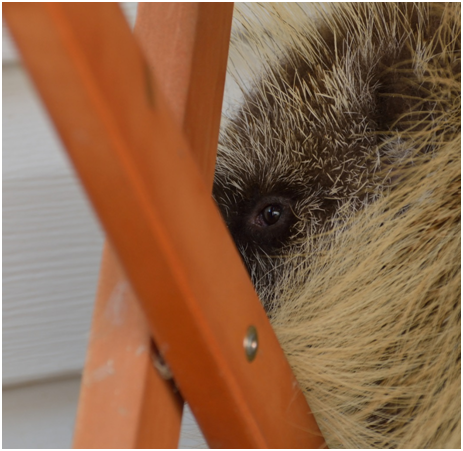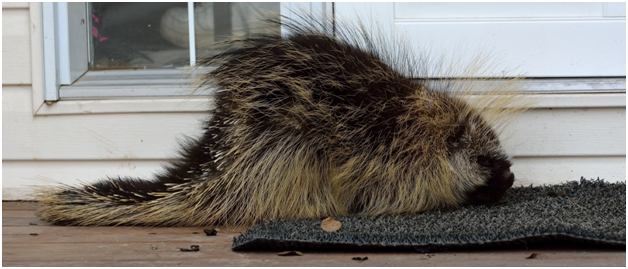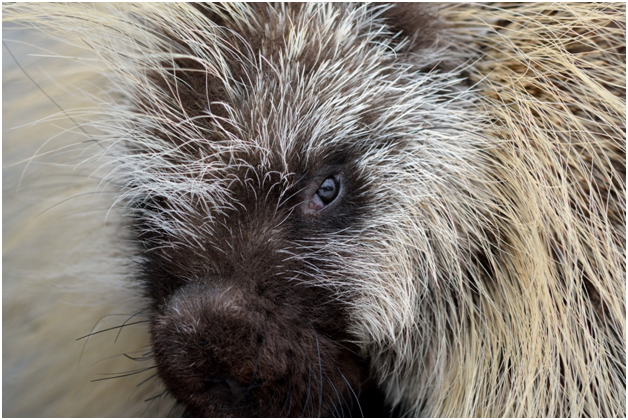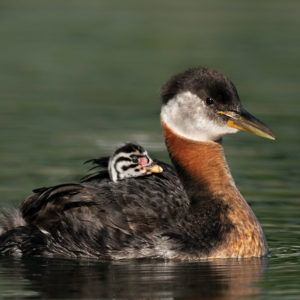A Prickly Visitor Dilemma — What to do with an injured wild animal
[separator headline=”h2″ title=”Sometimes the wild comes a-knocking…”]
When you live in the country, you expect to see some wildlife…but not necessarily sitting on your doorstep!

After the initial surprise, and mild aggravation related to finding an alternate exit for the dog’s morning ritual, I started to observe my prickly little visitor – its presence on the porch seemed unusual. As a city-kid, porcupines fascinated me, but my experiences with porcupines could be condensed to:
- They don’t get along with cars on highways
- Dogs + Porcupines = bad news
After moving to our acreage we quickly reaffirmed point #2, but had few interactions after that. Porcupines are generally nocturnal, and spend their daylight hours in trees, or in their dens, so finding one on the front porch, huddled under a deck-chair was an inconvenient novelty. A wild animal, with injury potential, in such close proximity to humans and their domestic animals is never desirable.
[separator headline=”h3″ title=”Now What?”]
What do you do when a critter decides “su casa es mi casa?” If you are in a city, you might call the local animal control office to relocate the animal, but ideally, you leave it alone and it goes home. For rural folks, the animal control officers generally deal with domestic animal complaints or issues related to animals posing imminent threat to humans or domestic animals. This situation didn’t really fit either scenario, so we just watched, knowing that eventually the porcupine would go home…but he didn’t.
[separator headline=”h3″ title=”Why our Porch?”]

Over the course of a week, we watched the little porcupine return to the porch location every morning before dawn, after leaving for only a few hours each night. We tried to make the location less attractive to it by removing the chair and other cover, but still it returned, lumbering slowly up the stairs and into the corner of the porch for its daily slumber. Eventually, the porch was returned to normal, and we co-existed with our visitor.
For the first few days I hoped the porcupine was a pregnant female – it was the season (spring), and porcupettes are adorable! After the first 48 hours though, it was obvious that no babies were on the way, so why else might this animal be on the doorstep for so long? There were only a few possibilities to consider:
- It was a young porcupine, driven from mom’s den looking for a new home or,
- It was sick or injured
We ruled out the first option by making the porch less attractive. After removing any possible comforts, we started using the door, interrupting the little pin-cushion as frequently as possible, but to no avail. Option 2, illness or injury, became most probable. So now what?
[separator headline=”h3″ title=”Injured Animal”]

Dealing with a sick or injured animal on your front porch is potentially risky. Some illnesses can be transmitted to humans or pets, but sick animals can also be unpredictable and, just like humans, lash out when in pain. At this point it seemed reasonable to carefully record its behaviours and contact our local wildlife rehabilitation society. Most regions in Canada have centres for injured wildlife care, and our local facility, the Wildlife Rehabilitation Society of Edmonton, has a hotline that will answer questions and give advice. For the porcupine, we started to notice that its mobility was impaired, it didn’t respond appropriately to other animals in its space, and it shivered for no apparent reason. Although it was spring in Alberta, the porcupine should have enough fat reserves (~50% of its body mass at the start of winter) to maintain body temperature. Something was definitely wrong, so we made the call for more information and advice.
[separator headline=”h3″ title=”Logical Course of Action”]
[one_third][/one_third][one_third]
[teaser img=”/wp-content/uploads/2013/12/Musk-Turtle_Jeroni-Hefner-300×2002.jpg”][separator headline=”h3″ title=”Wild Animals”]Need a list of Wildlife Rehabilitation Centres near you?
[button link=”/about/faq/wildanimals/” size=”medium” target=”_self” icon=”leaf” color=”blue” lightbox=”false”]click here[/button][/teaser]
[/one_third] [one_third_last][/one_third_last]
Once we knew the porcupine was sick, the decision to capture it and take it to the rehabilitation society was an easy decision for us, with the support of the local wildlife rehabilitation society. Knowing when to interfere with nature isn’t always an easy decision to make though. There are many factors that must be considered:
- Is the animal actually in need of human assistance?
- Is the animal likely to recover? Some injuries and illnesses are beyond help.
- Baby animals are generally best left to the care of their parents. Many animal parents leave their babies for extended periods of time, so before you “help” a baby, contact your local wildlife hotline.
- Can the animal be captured without causing harm to humans or further injury to the animal?
- If the animal isn’t captured, could there be harm to humans or domestic animals?
- Is there a local licensed wildlife rehabilitation center within a reasonable distance?
- It is illegal to capture and keep wild animals and birds on your own.
In our case, if the porcupine was left on its own, it was unlikely to fall prey natural predators on the doorstep. We assessed the risk to domestic animals as high, and there was a risk to humans from vehicular collisions with the slow moving animal. It was in everyone’s best interest to capture the porcupine and take it for medical assessment.
[separator headline=”h3″ title=”A Happy Ending”]
Once the porcupine was captured and transported to the Wildlife Rehabilitation Society of Edmonton, our lives returned to normal. The WRSE provided some updates and it was agreed that the porcupine would be released back onto our property when his wounds had healed. The porcupine, a small male, had an abscessed growth on his shoulder, and was seriously underweight, but had a good prognosis. After several weeks in “rehab”, the porcupine was released back “home” where, he has only been seen once since. I guess he didn’t think of the porch as his home after all.
 This article was contributed by guest blogger, Shauna Stevens.
This article was contributed by guest blogger, Shauna Stevens.
Born and raised a nature lover in Edmonton, Alberta, Shauna now lives near Chickakoo Lake in Parkland County, Alberta. A science teacher by profession, Shauna’s hobby time is spent tending and photographing the nature surrounding her. “Moving from the city to a rural area has been an eye-opener, and has provided me with unbelievable learning experiences that can be applied no matter where you live.”
Shauna’s photography work can be found at shaunastevens.500px.com. You can also connect with her on Twitter at @shaunashome or on Facebook at facebook.com/ShaunasHome.



